Winter …into Spring

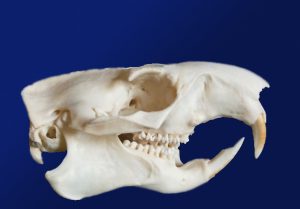
The time has come to practice your Monday Morning Quarterback skills. Not the weekend after the big game, but six weeks post-event. The “prognosticator of prognosticators, the seer of seers” has predicted our weather for the past six weeks. And not only has he done it this year, he’s done it for the past 135 years; now that’s one old gutsy rodent. And he’s made his predictions before a society of men in black coats and bowties, a cult of sorts—the “Inner circle” of the Punxsutawney Groundhog Club.
That’s right, on February 2 at 7:25 a.m. the famed rodent Punxsutawney Phil of Gobbler’s Knob, Pennsylvania, pulled the rug right out from under the likes of Al Roker and Glenn “Hurricane” Schwartz, and upstaged them by predicting the weather, and not just for a day or a week but for six weeks! Phil went snout-to-nose with an Inner Circle member who assured us that Phil the groundhog predicted six more weeks of winter. This society also assures us that Phil is “always correct.” I’ll let you be the judge. Were the past six weeks wintery?
How did this tradition—of relying on a groundhog in February to tell us if we should salt roads, get out shovels, and layer up or simply sport cardigans—get started? Well, apparently, it is tied to the Christian holiday Candlemas, which commemorates the ritual purification of Mary and is further tied to Jewish beliefs. February 2 also has pre-Christian traditions dating back to ancient Roman times. There are lots of superstitions wrapped up in this celebratory date. For the Feast of Lights people place candles in windows to chase away evil spirits. The winter flower, snowdrops, is related to that holiday because it looks like a candle piercing the snow, blooming as early as February. A number of European superstitions have the snowdrop as a harbinger of evil if brought inside, ranging from a death in the family to sour milk and spoiled eggs.
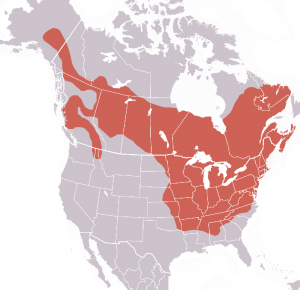
Candlemas Day is also the midpoint between the winter and summer equinox, and apparently superstition dictates that if the day is bright there will be more winter. In order for the groundhog to see his shadow upon leaving his hibernation there must be some sun.
Why the groundhog? Well, groundhogs hibernate; if they leave their den prematurely, a change of heart will return the critter to his winter abode to resume a state of dormancy. If he were to remain above ground one might anticipate an early spring—that is if groundhogs know anything about future forecasts. Although touted by the Groundhog Club as “always correct,” let’s just say a tendency toward hyperbole is not beneath his handlers.
Groundhogs are known by other names as well—woodchuck and whistle-pig—because of their wood-gnawing habit and alarm call vocalizations. In “binomial nomenclature” they are called Marmota monax; these Latinized names are given to every identified member of the animal kingdom so that we all know which animal is the topic of discussion; put differently, “it keeps everyone on the same page.” The names are often descriptive; monax in Algonquian, language of the native North American Algonquin people, means essentially “digger.” This is fitting considering that an average burrow can cover a quarter acre and displace 400 pounds of dirt, and the main passage may be as long as 50 feet. The term marmota refers to marmots: All are burrowing members of the squirrel family.
Their abandoned burrows are important for other wildlife, since rabbits, skunk, foxes, chipmunks, weasels, mice, otter, opossum, raccoon, even gamebirds like quail, pheasant, and ruffed grouse can use their dens.
Woodchucks are well designed for digging. Their fur sheds dirt and their nostrils and ears are valvular, closing during excavation. Their dens are especially designed with an entrance hole that is deeper than the first main passage, which slopes upward to keep out water. The burrow then turns into a labyrinth of sorts with a number of side rooms for various purposes like scat disposal.
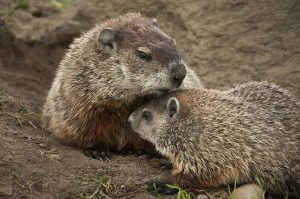
The winter den is normally in the woodlands in the roots of trees with cover during hibernation; the summer den is placed most importantly near sources of food, often agricultural fields. Like a number of the mammals we have discussed in our stories their pelage is made up of guard hairs and a softer woolier coat. The color is varied, the outer coat being brownish and grizzled and the inner coat softer cinnamon or pale gray. Some older individuals are very dark in color.
The size of an adult woodchuck varies depending on the season. In the spring after hibernation their average weight would be about five pounds, but in the fall, prior to winter’s slumber, they can weigh up to 15 pounds. Their length ranges from 16 to 26 inches, including their approximately six-inch tail. They have short legs, advantageous for traveling in burrows. When they run they have a distinctive lumbering waddle but when put to the test an alarmed woodchuck can move nearly 10 mph.
They can climb trees to evade certain predators and they can also swim. One day about 15 years ago I was beneath a cedar when a red-tailed hawk let out a long loud screech. Then I heard something falling through the crown of the tree, hitting branches as it fell down the length of the trunk. With a massive thud a groundhog landed at my feet and scurried off with one of my Brittany spaniels in hot pursuit. The rodent beat my dog to its burrow. I had assumed the hawk had dropped it, not knowing at the time that woodchucks climb trees. In retrospect I think the hawk knocked it off the branch or couldn’t carry its weight. I would have guessed it to be 20 pounds but now knowing the record weight to be 16 pounds I’ve tempered my hyperbole. I bet that bad boy beat the record.
Groundhogs are primarily vegetarians, eating clover, chickweed, alfalfa, dandelions, fruits, vegetables, and grains. They will also eat insects and birds’ eggs. As rodents they must gnaw on branches and bark to keep their ever-growing upper and lower incisors at bay. These two pairs of teeth, unlike those of all other rodents, are “white.” The face of each tooth is made of enamel and the back is a softer material called dentine. When the top incisors grind against the bottom pair, the dentine wears away more swiftly, sharpening and giving a chisel-shaped edge to the teeth.
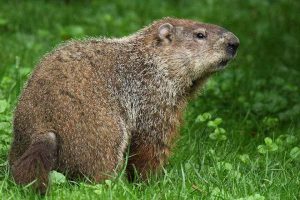
Woodchucks are gourmet meals on a number of higher predators’ menus, including bobcat, fox, bear, and hawks, while snakes will eat the young. Younger ones are said to be tasty human fare, according to my LL Bean Cookbook, but don’t forget the sour cream and mustard, and be sure to soak overnight (the groundhog, that is).
Groundhogs are diurnal solitary animals, and after mating in March or April the female raises the young. The pups are blind, toothless, and hairless. The mother nurses the offspring, numbering one to nine, for about two months and they then disperse from the natal territory. There is only one brood per breeding season. Although they are sexually mature at one year of age, only 20 to 40 percent of yearlings will raise families.
Their tunneling and eating habits put them in conflict with humans. At home we joke about the 1913 Fish and Game Laws of New Jersey that call for the Board of Chosen Freeholders to pay a premium for registered voters who destroy a woodchuck. The amount is to be determined by the Freeholders and not to exceed 50¢. The law goes on to detail many complexities, my favorite being that if you collect a bounty fraudulently you could pay up to $500 and even do jailtime. All of this might explain why 30 years ago, when Cumberland County had few groundhogs, the best-known population was at the Leesburg Prison. Possibly they were ratting out their kin for bounty (sorry, couldn’t resist that one; the prison part is true).
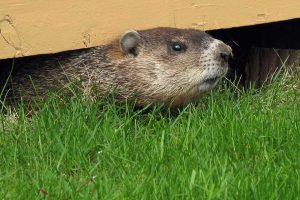
Let’s put the prejudice against woodchucks into the cultural context of 1913: Not only were they causing trouble for farmers’ tending their crops as they still do today, but livestock was a big issue. Know that 1908 was the first year that cars surpassed horses as the primary means of transport. However, the automobile was not produced in mass quantities until 1916, so that many people continued to rely on four-legged transporation. A groundhog burrow is a serious menace to livestock; it’s not just a flat tire but a likely death sentence. Farmworkers have broken their legs in the burrows as well. While groundhogs have made a strong comeback in our region, you can surely understand why a bounty was of cultural import in the early 1900s. Even today there are liberal laws around taking groundhogs.
On the positive side, the University of Michigan’s Museum of Zoology has compiled a list of biomedical research linked to woodchucks—“investigating hepatitis B, metabolic function, obesity, energy balance, the endocrine system, neurology, cardiovascular disease, cerebrovascular disease, and neoplastic disease.”
Yes, groundhogs can be a nuisance especially for farmers and gardeners. They can also prove detrimental to foundations. However, do not use poisons to eliminate them. Not only is it illegal, but often nontarget species like hawks, scavengers, and domestic pets are secondarily killed. For the same reason it is best to use mechanical traps on vermin.

Trapped animals should not be relocated; it is illegal to transport and release wildlife. Often you have simply relocated the problem, but more importantly wildlife moved from one location to another can introduce diseases for which another group does not have immunities. This is true for many species, especially reptiles. A second issue is that animals have territories; an interloper can be attacked and killed if moved into another creature’s space.
So back to Punxsutawney Phil, you might be wondering how an animal with an average lifespan of four to six years has been predicting the weather for 135 years. Well, you’re asking the wrong person, because as long as Santa keeps delivering gifts, I’m a believer. Besides, there are some things that are simply magical—and quite possibly a woodchuck might be one of them. Yeah, I’d better get a larger mailbox for the fan mail on that comment!
Sources:
Massachusetts Division of Fisheries and Wildlife
New Jersey Wildlife Profiles, NJ Div. of Fish and Wildlife
Fish and Game Laws of NJ, 1913
Animal Diversity Website
Cleveland Museum of Natural History, Creature Features
Naturally Curious, Mary Holland









